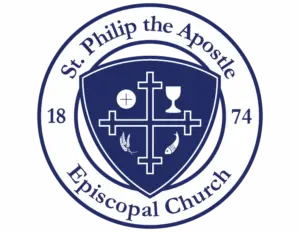Philip the Apostle
Image: Philip the Apostle by Peter Paul Rubens (1577-1640) collection of the Spanish National Art Museum, the Museo del Prado in Madrid.(Public Domain)
Our church is named after Philip the Apostle, one of the Twelve Apostles of Jesus according to the New Testament. Later Christian traditions describe Philip as the apostle who preached in Greece, Syria, and Phrygia (part of modern Turkey).
The Synoptic Gospels list Philip as one of the apostles. The Gospel of John recounts Philip’s calling as a disciple of Jesus.[John 1:43] Philip is described as a disciple from the city of Bethsaida, and the evangelist connects him with Andrew and Peter, who were from the same town. He also was among those surrounding John the Baptist when the latter first pointed out Jesus as the Lamb of God. It was Philip who first introduced Nathanael (sometimes identified with Bartholomew) to Jesus. According to Alban Butler’s book The Lives of the Fathers, Martyrs and Other Principal Saints, (New York, D&J Sadler and Company, 1864), Philip was among those attending the wedding at Cana.
Of the four Gospels, Philip figures most prominently in the Gospel of John. Jesus is asked by Philip on how to feed the 5,000 people. Later he appears as a link to the Greek community. Philip bore a Greek name, may have spoken Greek, and may have been known to the Greek pilgrims in Jerusalem. He advises Andrew that certain Greeks wish to meet Jesus, and together they inform Jesus of this [John 12:21]. During the Last Supper, when Philip asked Jesus to show them the Father, he provides Jesus the opportunity to teach his disciples about the unity of the Father and the Son.
Philip the Apostle should not be confused with Philip the Evangelist, who was appointed with Stephen to oversee charitable distributions (Acts 6:5).
Later stories about Saint Philip’s life can be found in the anonymously written Acts of Philip. This non-canonical book recounts the preaching and miracles of Philip. Following the resurrection of Jesus, Philip was sent with his sister Mariamne and Bartholomew to preach in Greece, Phrygia, and Syria. Included in the Acts of Philip is an appendix, entitled “Of the Journey of Philip the Apostle: From the Fifteenth Act Until the End, and Among Them the Martyrdom.” This appendix gives an account of Philip’s martyrdom in the city of Hierapolis. According to this account, through a miraculous healing and his preaching, Philip converted the wife of the proconsul of the city. This enraged the proconsul, and he had Philip, Bartholomew, and Mariamne all tortured. Philip and Bartholomew were then crucified upside-down, and Philip preached from his cross. As a result of Philip’s preaching the crowd released Bartholomew from his cross, but Philip insisted that they not release him, and Philip died on the cross. Another legend is that he was martyred by beheading in the city of Hierapolis.
Relics of Philip the Apostle are in the crypt of Basilica Santi Apostoli, Rome.
Philip is commonly associated with the symbol of the Latin cross. Other symbols assigned to Philip include: the cross with the two loaves (because of his answer to the Lord in John 6:7), a basket filled with bread, a spear with the patriarchal cross, and a cross with a carpenter’s square.
The feast day of Philip, along with that of James the Less, is traditionally observed on 1 May, the anniversary of the dedication of the church dedicated to them in Rome (now called the Church of the Twelve Apostles).
Adapted from the Wikipedia page on Philip the Apostle
St. Philip’s Episcopal Church, Joplin
The Reverend Robert C. Wall was the first rector of St. Philip’s Church in Joplin, Missouri, under the Right Reverend Charles Franklin Robertson, Bishop of the Diocese of Missouri.
An Irishman by birth, Wall served parishes in Indiana, Missouri, Ohio, and Michigan during his career,. Ordained to the priesthood in 1863, he died on 28 November 1905 in Lexington, Sanilac County, Michigan while serving at the Church of the Good Shepherd in Lexington.
A Lexington history noted: “He was a forceful man, a man of very definite opinions. He firmly believed in the Bible and its teachings and attempted to bring knowledge of the Bible to every member of the parish.”
When Wall gave the first Episcopal services in the city of Joplin on February 22, 1874 the town of Joplin had been incorporated for only a year.
There were nine original communicants of St. Philip’s:
- Dr. Thomas C. Mercer,
- Mrs. Katie L. Mercer
- Mrs. Clara M. Jackson
- Mrs. J. C. Beamer
- Mrs. J. G. Guthrey
- Mrs. McCracken
- Miss McCraken
- Miss Ellen M. Mallet
- Mr. J. G. Guthrey.
St. Philip’s was organized as a parish in May 1891. The pictures of the old church seen below were probably taken in 1903.
In the summer of 1908 the cornerstone of St. Philip’s Church at 706 Byers was laid and a special service held.
On June 22, 1911 Bishop Sidney Catlin Partridge, second Bishop of The Diocese of West Missouri dedicated the new stone church.
Rectors of St. Philip’s parish
- 1901 Alexander Coffin
- 1902 – 1913: Charles Albert Weed
- 1914 – 1916: Richard Colgate Talbot
- 1916 – 1918: Henry Neal Hyde
- 1918 – 1926: Anthony G. VanElden
- 1926 – 1927: G. B. Norton
- 1927 – 1930: Bernard N. Lovgren
- 1930 – 1955: Alfred L. duDamaine
- 1955 – 1985: David Patrick
- 1985 – 1994: Keith B. Whitmore
- 1996 – 2001: Daniel L. Erdman
- 2001 – 2004: Frank M. Swindle
- 2005 – 2022: Frank C. Sierra
- 2022 – Present: Ted Estes
